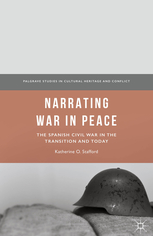Book Review: , Narrating War in Peace: The Spanish Civil War in the Transition and Today
 Katherine O. Stafford, Narrating War in Peace: The Spanish Civil War in the Transition and Today. New York, NY: Palgrave MacMillan, 2015. 197 pp.
Katherine O. Stafford, Narrating War in Peace: The Spanish Civil War in the Transition and Today. New York, NY: Palgrave MacMillan, 2015. 197 pp.
Katherine Stafford’s Narrating War in Peace: The Spanish Civil War in the Transition and Today presents a refreshing contribution to the debates about the historical memory of Spain’s twentieth-century history. Studying a variety of texts and images over a long period of time, Stafford explores how the Spanish Civil War has been “reconceptualized, renarrated, and reconsidered to accommodate a variety of identities and to respond to various historical, political, and social realities.”
How has the changing narrative of the Spanish Civil War responded to “changes in ethical, ideological, and aesthetic values”? Stafford answers this question through four case studies from the transition to democracy (1975-1981) and the first decade of the twenty-first century (2000-2012).
Central in Stafford’s approach is the notion of “lieux de mémoire,” or “sites of memory,” developed in the 1980s by the French historian Pierre Nora, who argued that historic monuments become symbols of collective memory. Opening up Nora’s definition, Stafford analyzes her four cases as “sites” or “spaces” through which Spaniards remembered the war. They are Agustí Centelles’s war photography, which was recovered in a series of exhibits starting in the late 1970s; Picasso’s Guernica, which was painted in 1937 but wasn’t shown in Spain until 1981; Jaime Camino’s documentary films La vieja memoria (1977) and Los niños de Rusia (2001); and the Civil War novels of Antonio Muñoz Molina, including his recent The Dark Night of Time (2009). Rather than focusing on the symbolism or archetypes of each case, Stafford analyzes the reciprocal changes in multiple narratives of culture and conflict, tracking how these texts and images communicate the “desires and values of different generations and social groups.”
Stafford analyzes the reciprocal changes in multiple narratives of culture and conflict.
Stafford identifies three major shifts between the years of the transition and the first twelve years of the twenty-first century. First, a shift from heroes to victims. While the narratives composed during and immediately after the dictatorship tended to center on the heroism of the defeated Republicans, recent years have focused on the individuals who suffered Franco’s crimes. Stafford argues that this shift was an attempt to grapple with and compensate for the lack of retribution for the perpetrators. A second shift is from “ideology to affect.” Spain’s transition to democracy, Stafford argues, tended to produce “sweeping metanarratives” that tried to vindicate the Republican cause but that were low on sadness or emotion, as they did not mourn the victims of the war and the dictatorship. In the twenty-first century, on the other hand, emotions are put front and center. The third shift is from “trauma to identification,” evident, for example, in the way that works like Guernica and Centelles’s photographs are viewed today.
The depth and breadth of Stafford’s work combined with her multi-media analysis in each of the four case studies paves new ground for Spanish cultural studies. Stafford investigates the “evolving generational, ethical, philosophical, and political concerns” that the war has inscribed into cultural practices in Spain. She notes in her conclusion that the Civil War continues to be a fundamental, defining element of Spanish identity. Her book advocates for ethical awareness and social justice in Spain today through “active and reflective thinking about the changes in values.” Stafford reminds us that within the “hypermodern ethics” in the new millennium we must continue to question romanticized narratives about the past that may have caused “cultural and generational biases.” To actively participate in contemporary politics we should continue to engage with the complexities of representations of war and trauma.
Evelyn Scaramella is an Assistant Professor of Spanish at Manhattan College. Her book in progress, Translating the Spanish Civil War: The Avant-Garde, Antifascism, and Literary History, examines the literary collaborations and translations between English- and Spanish-speaking writers during the Spanish Civil War.














